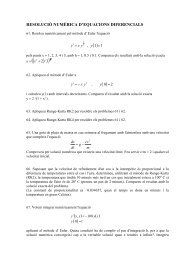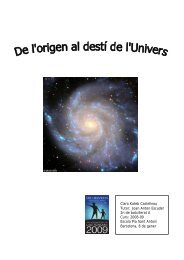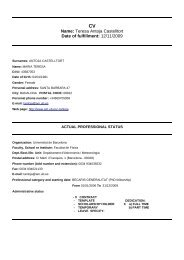Universitat de - Departament d'Astronomia i Meteorologia ...
Universitat de - Departament d'Astronomia i Meteorologia ...
Universitat de - Departament d'Astronomia i Meteorologia ...
Create successful ePaper yourself
Turn your PDF publications into a flip-book with our unique Google optimized e-Paper software.
2.6. The X-ray counterpart: RX J1826.2−1450 65<br />
that the minimum χ 2 is achieved for the spectrum broa<strong>de</strong>ned by σbroad = 105 ± 1<br />
and 126±12 km s −1 , respectively. Since the template has a rotational broa<strong>de</strong>ning of<br />
σHD 168075 = 79 ± 3 km s −1 (Penny 1996), we need to sum this quadratically to σbroad<br />
in or<strong>de</strong>r to get the true rotational broa<strong>de</strong>ning of LS 5039. Therefore, we obtain<br />
131 ± 3 and 149 ± 12 km s −1 for the two resolutions. These numbers are in excellent<br />
agreement with the value V sin i = 131 ± 6 km s −1 obtained McSwain et al. (2001).<br />
2.6 The X-ray counterpart: RX J1826.2−1450<br />
The X-ray binary name that appears in the Liu et al. (2000) catalog of HMXBs,<br />
which always comes from X-ray satellites, is RX J1826.2−1450, after the ROSAT All<br />
Sky Suvey (RASS). However, in the <strong>de</strong>finitive version of the ROSAT Bright Source<br />
Catalog (RBSC) it is listed as 1RXS J182615.1−145034. In this section we present<br />
the long-term X-ray lightcurve obtained by ASM/RXTE, pointed observations by<br />
PCA/RXTE and pointed observations by BeppoSAX.<br />
2.6.1 The ASM/RXTE data<br />
As we have mentioned in Sect. 2.4.3, LS 5039 was inclu<strong>de</strong>d at our request in the<br />
catalog of the All Sky Monitor (ASM), onboard the Rossi X-ray Timing Explorer<br />
(RXTE), in or<strong>de</strong>r to follow its behavior in the X-ray domain. An analysis of the<br />
first ∼ 33 months of ASM/RXTE data was presented in Ribó et al. (1999). Here<br />
we report ASM/RXTE 19 observations spanning almost six and a half years (MJD<br />
50136.78–52501.41), from 1996 February to 2002 August. The dataset contains more<br />
than 1800 daily flux measurements in the energy range 1.5–12 keV. Each data point<br />
represents the one-day average of the fitted source fluxes from a number (typically 5–<br />
10) of individual ASM dwells, of ∼90 s each (see Levine et al. 1996 for more <strong>de</strong>tails).<br />
The one-day average light curve is shown in Fig. 2.14. The big gap between Modified<br />
Julian Date ∼ 50400 and ∼ 50500 corresponds to the passage of the Sun close to<br />
the source during the first year of observations. This gap repeats the following years<br />
(near MJD 50800, 51150, 51900 and 52250). That is the reason why we have a<br />
dataset of only 1800 one-day average points spanning nearly ∼ 2400 days.<br />
19 Quick-look results provi<strong>de</strong>d by the ASM/RXTE team.






